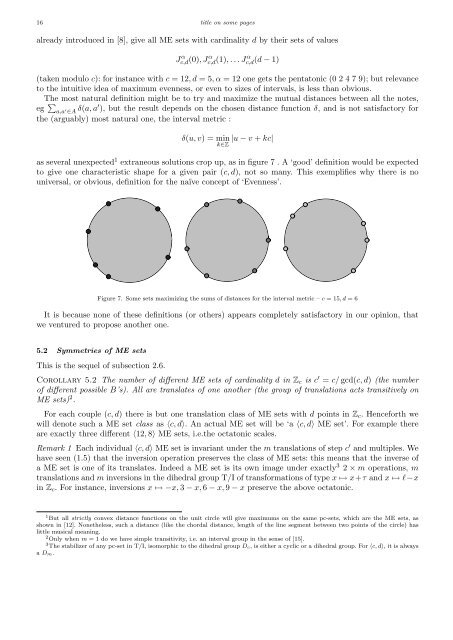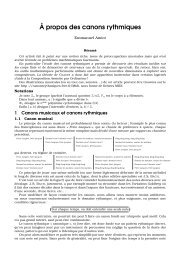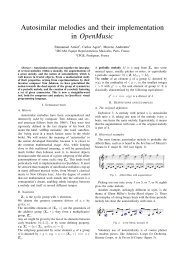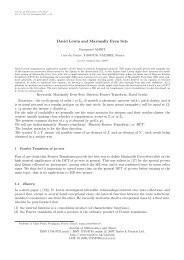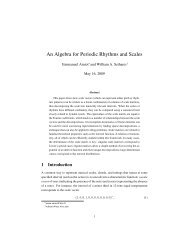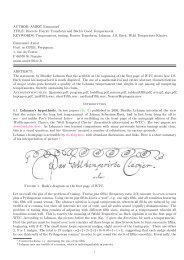Emmanuel Amiot Modèles algébriques et algorithmes pour la ...
Emmanuel Amiot Modèles algébriques et algorithmes pour la ...
Emmanuel Amiot Modèles algébriques et algorithmes pour la ...
Create successful ePaper yourself
Turn your PDF publications into a flip-book with our unique Google optimized e-Paper software.
16 title on some pages<br />
already introduced in [8], give all ME s<strong>et</strong>s with cardinality d by their s<strong>et</strong>s of values<br />
J α c,d (0), J α c,d (1), . . . J α c,d (d − 1)<br />
(taken modulo c): for instance with c = 12, d = 5, α = 12 one g<strong>et</strong>s the pentatonic (0 2 4 7 9); but relevance<br />
to the intuitive idea of maximum evenness, or even to sizes of intervals, is less than obvious.<br />
The most natural definition might be to try and maximize the mutual distances b<strong>et</strong>ween all the notes,<br />
eg <br />
a,a ′ ∈A δ(a, a′ ), but the result depends on the chosen distance function δ, and is not satisfactory for<br />
the (arguably) most natural one, the interval m<strong>et</strong>ric :<br />
δ(u, v) = min |u − v + kc|<br />
k∈Z<br />
as several unexpected 1 extraneous solutions crop up, as in figure 7 . A ‘good’ definition would be expected<br />
to give one characteristic shape for a given pair (c, d), not so many. This exemplifies why there is no<br />
universal, or obvious, definition for the naïve concept of ‘Evenness’.<br />
Figure 7. Some s<strong>et</strong>s maximizing the sums of distances for the interval m<strong>et</strong>ric – c = 15, d = 6<br />
It is because none of these definitions (or others) appears compl<strong>et</strong>ely satisfactory in our opinion, that<br />
we ventured to propose another one.<br />
5.2 Symm<strong>et</strong>ries of ME s<strong>et</strong>s<br />
This is the sequel of subsection 2.6.<br />
Corol<strong>la</strong>ry 5.2 The number of different ME s<strong>et</strong>s of cardinality d in Zc is c ′ = c/ gcd(c, d) (the number<br />
of different possible B’s). All are trans<strong>la</strong>tes of one another (the group of trans<strong>la</strong>tions acts transitively on<br />
ME s<strong>et</strong>s) 2 .<br />
For each couple (c, d) there is but one trans<strong>la</strong>tion c<strong>la</strong>ss of ME s<strong>et</strong>s with d points in Zc. Henceforth we<br />
will denote such a ME s<strong>et</strong> c<strong>la</strong>ss as 〈c, d〉. An actual ME s<strong>et</strong> will be ‘a 〈c, d〉 ME s<strong>et</strong>’. For example there<br />
are exactly three different 〈12, 8〉 ME s<strong>et</strong>s, i.e.the octatonic scales.<br />
Remark 1 Each individual 〈c, d〉 ME s<strong>et</strong> is invariant under the m trans<strong>la</strong>tions of step c ′ and multiples. We<br />
have seen (1.5) that the inversion operation preserves the c<strong>la</strong>ss of ME s<strong>et</strong>s: this means that the inverse of<br />
a ME s<strong>et</strong> is one of its trans<strong>la</strong>tes. Indeed a ME s<strong>et</strong> is its own image under exactly 3 2 × m operations, m<br />
trans<strong>la</strong>tions and m inversions in the dihedral group T/I of transformations of type x ↦→ x+τ and x ↦→ ℓ−x<br />
in Zc. For instance, inversions x ↦→ −x, 3 − x, 6 − x, 9 − x preserve the above octatonic.<br />
1 But all strictly convex distance functions on the unit circle will give maximums on the same pc-s<strong>et</strong>s, which are the ME s<strong>et</strong>s, as<br />
shown in [12]. Non<strong>et</strong>heless, such a distance (like the chordal distance, length of the line segment b<strong>et</strong>ween two points of the circle) has<br />
little musical meaning.<br />
2 Only when m = 1 do we have simple transitivity, i.e. an interval group in the sense of [15].<br />
3 The stabilizer of any pc-s<strong>et</strong> in T/I, isomorphic to the dihedral group Dc, is either a cyclic or a dihedral group. For 〈c, d〉, it is always<br />
a Dm.


